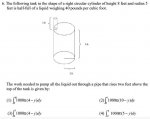kpx001 said:
How did u get the function, and also the distance? its half full so i understand 0 to 4 to go to the top of the cylinder but dont i take in account the additional +2 feet i have to go up?
and for the function did u split it into a graph so u have the points 0,5 and and 5, 8 ? thanks
If the function wasn't provided for you, you need to check the prerequisites for this class or complain to your professor.
But you are taking into account a height of 10 feet. The limits of integration are for the function that gives the force required to move this liquid through a distance. The force is variable here, and that is the function we're integrating.
What I wrote earlier was only partially correct, and I apologize for the confusion (I still think lifting is negative by definition, but this is not the forum for that discussion).
I wrote that you needed to move the entire mass of liquid through the entire distance. That's not exactly correct, because once the first drop comes out of the tube, the force decreases (less liquid doesn't weigh as much as your original volume). Weight starts coming off. The limits of integration are from the top of the cylinder of water, which is where the force is at its maximum value still, to the bottom (4 feet lower), where the force would be 0, because there is no liquid left.
The force function starts decreasing once the liquid weighs less. So, that's why we need the integration.
The distance over which that force changes is represented as 10-y. The 10 is sort of a maximum value that you will have to pump any drop of water with the entire force of the column bearing down on you (the diameter of the tube doesn't affect how much WORK you do, so just add that height). I'm sure someone will correct me if I'm wrong, but I think it should always be written as ((top-to-bottom-distance) - y) with this type of setup. As I said, if physics was not a prerequisite and you weren't given this function, complain.


